Partner Yoga or Pair Yoga – The benefits & a few Poses
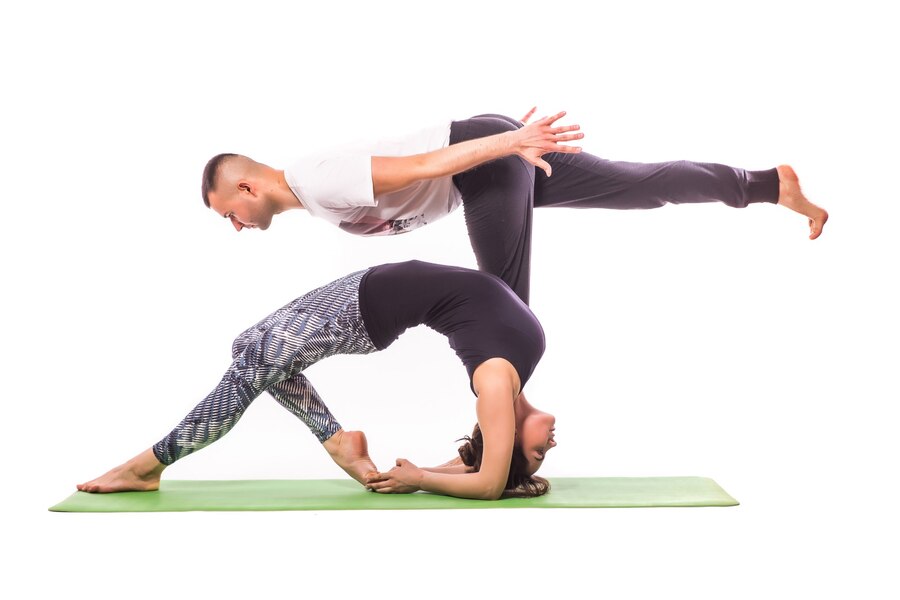
What is Partner Yoga or Pair Yoga?
Yoga is a way of living and a method to unify the body, heart and mind. The word yoga exercise really stemmed from the Sanskrit word ‘Yuj’ suggesting to yoke or to join. Partner yoga or Pair Yoga does exactly that, Essentially a method to unify or connect 2 individuals. Partner yoga is an excellent technique to develop stronger connections, communication, depend on, relationships and also even social skills. The main concepts at play in partner yoga are based on building a connection and also intimacy via breath work, movement, trust and play.
Partner yoga (Couple Yoga) doesn’t have to be all acrobatics, and neither does it have to be all lovey-dovey. You can practice partner yoga with just about anyone. It is a great way to build stronger communication and connection within friendships, families, and your significant other and kids love it too. The usual design of a class starts softly with some connection and breathwork. Then some easy trust poses maybe peak to some balances or standing poses before moving back down to the floor for relaxation. The best bit of partner yoga is that these poses will deliver some giggles, break down boundaries and lift the spirit.
Here are a few benefits of partner yoga:
1. Building Trust
Partner Yoga (Couple Yoga) practices rely totally on communication and trust between the participants. To achieve the poses or shapes instructed the couple must work together. They must focus as one. This may be easy for some and harder for other pairs in the beginning. But, by learning to lean on each other and discover each other’s strengths and weaknesses we actually learn a deeply meaningful life lesson, that we are all interdependent. We are in this life alone, yet we are all part of the same bigger picture.
In fact, partner yoga participants often achieve greater results, go deeper or stand stronger than they would have been able to alone. This is also true of life. When we work and connect as one we can accomplish the most impossible tasks.
2. Deepening the physical and emotional connection.
Spending time fully present at the moment is one of the reasons we practice yoga. To spend time fully present at the moment in unison with another person and soul adds a whole other dimension. When we have to focus, communicate and move as one to learn to let go and embrace having full faith in another being.
3. Communication.
Communication is key to enjoying the full benefits of partner yoga. To understand your and your partner’s limits you need to communicate. To achieve to focus, alignment and balance required to achieve the poses it is essential to communicate. So, if you want to build communication skills or deepen communication within a relationship give partner yoga a go.
4. Deepening of stretching and resistance.
You and your partner will act as weights for each other. Sometimes anchoring each other in poses. Sometimes using the weight to send the partner deeper into the stretch and sometimes pulling against your partner in opposition. Having another body to work with can take practice to new levels and some new poses might be possible that weren’t before.
5. Fun and laughter.
Traditional Yoga can be a serious practice and joyful in a solitary way. Uplift yourself and let go with partner yoga. You will find your partner is a source of fun and giggles. There will possibly be moments of awkwardness followed by moments of connection and laughter. The more you let go, the more you will enjoy the process.
5 Partner Yoga Poses To Get you started:
The following poses are beginner partner yoga poses. All you need is yourself, a mat and a willing partner. Hold on tight and enjoy!! Remember, to listen to your own body as well as your partners and communicate with your partner. If something doesn’t feel right stop immediately. If you have pre-existing medical conditions seek advice from a professional before starting any kind of yoga.
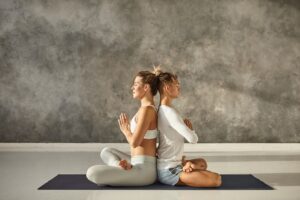 1. Partner Yoga Breath.
1. Partner Yoga Breath.
- Start in a comfortable seated position, with your backs pressing lightly against each other, connected from the sacrum to the shoulders.
- Begin to breathe allow the breath to be natural. Try to feel your partner’s breath against your back. You may find your and your partner’s breath starts to work in synchronicity. Don’t force it to let it happen naturally
- Continue this for 3-5 minutes.
2. Partner Yoga Cat-Cow Pose
- This is the classic cat/cow movement.
- Partner 1 begins in a tabletop position. On all fours with the wrists directly underneath the shoulders and the knees directly underneath the hips.
- Partner 2 carefully sits sacrum to sacrum (the flat triangle part at the base of the spine at the back of the hips), facing away from partner 1.
- Do not sit on the back and spine!!! Avoid this pose if you have back problems.
- Holding partner 1’s hips partner 2 lies backward.
- Partner 1 starts to make cat/cow movements exhaling as they round their back, inhaling as they push their chest forward.
- Partner 2 is relaxed and it should feel like a lovely back massage.
- To stand up partner 2 holds partner 1’s hips and carefully sits up before standing and swapping over.
3. Double Nakasana (Boat Pose)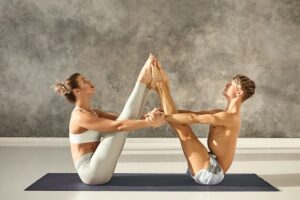
- Begin seated facing each other.
- Bend your knees up and press the balls of your feet together.
- Grab and hold tight to each other’s forearms.
- Now, you may have to re-adjust the distance between you.
- Press firmly into each other’s feet and start to lift them up simultaneously. Hold tight with your arms.
- Extend your legs as much as you can.
- Now try to lift your chest and straighten your back.
- To exit carefully bend your knees and release your feet to the floor.
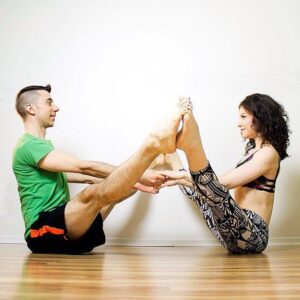 4. Wide-Legged Boat Pose
4. Wide-Legged Boat Pose
- From Double boat pose.
- Before extending up your legs.
- Press your feet firmly.
- Then open the knees and take the legs under the arms.
- Finally, extend the legs out wide and straight.
- To exit reverse the movement.
5. Double Tree Pose (Vrikshasana)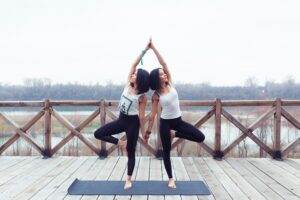
- Standing side by side.
- Link your arms or hold each other’s waist.
- The ground has been done through your inner feet.
- Bring up your outer legs- either to the calf or the inner thigh (avoid pressing on the knee).
- Then bring your outer arms up to meet above your head.
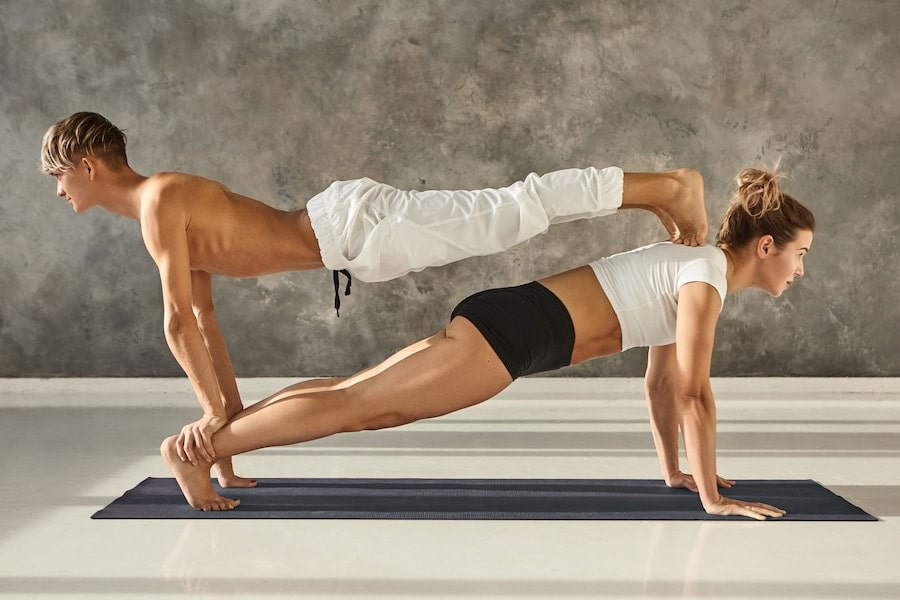
Recent Comments